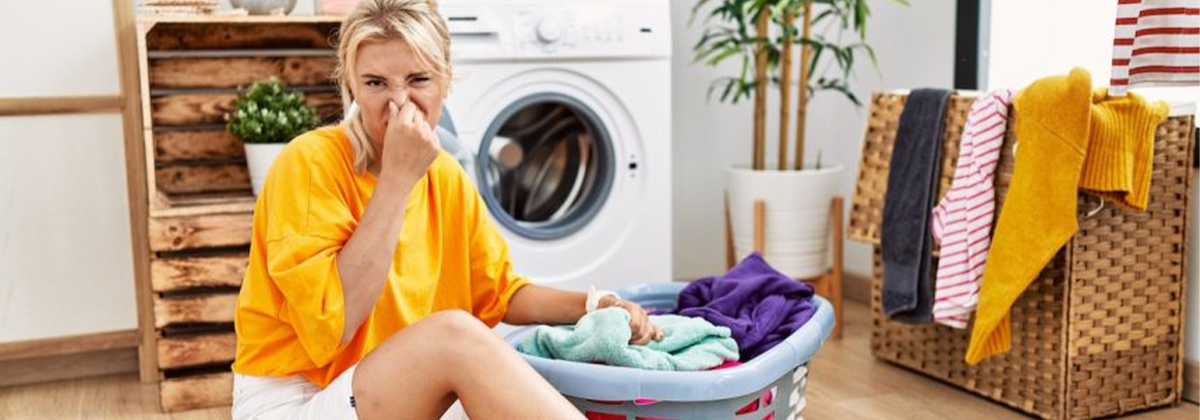13 Apr Removing Mould From Clothes (Part 1)
Did you forget to take your clothes out of the washing machine? Have you ever put your wet towel in your bag or crumpled your wet T-shirt and left it in your wardrobe? Moulds can spread quickly in tiny spaces, and getting rid of the smell and their growing organisms require some professional tricks. Fortunately, there are various commercial and natural solutions to deal with moulds. In addition, you can wash your clothes with a washing machine or dry them with a dryer to get rid of them. We show you several solutions for each of these options for removing mould from clothes.
Definition of moulds
Moulds are a type of fungus that grows on any surface. Spores (eggs of fungi) are found inside and outside the house and will multiply if there’s moisture. These moulds hurt human health and emit a strong and unpleasant smell.
Symptoms of mould
Usually, a strong and unpleasant odour is the most obvious sign that these little inhabitants have taken over your clothes. But there are some other ways to identify moulds, which are:
Stain
Although most mushrooms are green or black, some spores may be orange or red. The colour of the mould depends on the food source, the region or the age of the mould.
Allergy
Symptoms such as sneezing, runny nose and itchy eyes when wearing clothes indicate the presence of these foreign invaders.
Rashes
It reacts quickly if your skin is in direct contact with mouldy clothes.
Why should you remove mould from clothes?
When the population of spores is low, they don’t smell much. In this case, you may be tempted to ignore or delay removing them from your clothes. The pungent smell of mould gives us enough motivation to do this task.
Avoiding unpleasant side effects on health
People’s reactions to moulds are different. While some people may not react to them, others may have allergic reactions and symptoms of asthma and shortness of breath appear in them. Children are allergic to mould. Studies have shown that if children under seven years of age are exposed to mould, their risk of developing asthma increases.
Preventing the spread of mould
You might think that mould growth on clothing is a local issue. But spores travel through the air and spread faster than you might think. Your clothes may be the only entrance for them to enter your home. Therefore, cleaning these bacteria as soon as you know their existence is essential. Remember that spores can survive and hibernate in adverse environmental conditions like sunny or dry weather. When winter comes, or the weather becomes humid, they increase and spread within 24 to 48 hours.
Keeping clothes in proper conditions
These bacteria smell and look horrible and destroy clothes made from natural fibres. As a result, the clothes fade over time, and the fabric weakens.
Removing mould from clothes
Each washing method has several ways to remove mould from clothes.
Washing methods
What method do you usually use to wash your clothes? Do you machine wash them, or do you prefer hand washing? Do you dry your clothes with a dryer? Anyway, here we teach you the best ways to remove mould.
Wash with a washing machine.
If the mould infestation isn’t out of control, it will likely be removed by washing and drying clothes. Most fungal species are killed by exposure to water above 140 degrees Fahrenheit. Fortunately, most washing machines have a “hot wash” program in which the water temperature reaches this level.
Removing contaminated clothing,
try to remove spores once they have spread; Don’t mix mouldy clothes with clean ones.
Choosing the hottest possible water mode
Cold or even warm water does not affect moulds. At the same time, you should ensure that the water temperature doesn’t damage the fabric.
Adding detergents
You can also use ordinary detergents.
Using optional methods
When the washing machine compartment is filled with water, please open it and add white vinegar, bleach, borax and other ingredients listed below. If the washing machine has room for such materials, add them to the device through this compartment.
Washing
Let the washing machine run two complete cycles.
Drying clothes
Sunlight is a natural killer of fungi and mould. Therefore, you should dry your clothes outside in direct sunlight.
Using a dryer
Transfer the clothes to the dryer immediately after the second round of washing.
Warning
If your clothes still smell bad after washing, don’t dry them; Because the spores haven’t been destroyed yet. Soak your clothes in vinegar or baking soda solution for 20 minutes and then rewash them.
Hand wash
If you have only one garment or towel to wash, a large bucket of hot water may be enough for you.
Fill the pan with hot water
Fill a pan or a large bucket with hot water.
Adding detergent
Add a cup of washing liquid to the water.
Adding a natural or commercial mould remover to the solution
You can use one or more of the ingredients we describe below.
Soaking the clothes
Soak the clothes in this solution and let it stay for 20 minutes.
Washing and drying
In this step, you must follow the instructions for washing in the washing machine.
For severe fungal infections
In addition to washing clothes with a washing machine, use hand washing. Let the clothes dry before putting them in the washing machine; Soak in this solution for 20 minutes.
Drying
If your clothes can only be dry cleaned, use a soft brush and remove as much mould as possible. Then take your clothes to the specialist and let him solve your problem. In addition, be sure to inform the dry cleaner that your clothes are stained with mould; so he knows what kind of stain remover he should use to remove the mould stain.
Natural detergents
If you don’t like to use chemicals at home, you can try the following natural ingredients:
Borax
Borax was discovered 4000 years ago, a common substance for removing mould. When this substance comes into contact with hot water, it converts water molecules into hydrogen peroxide, a natural substance to remove mould. Borax is an effective fungicide and herbicide, insecticide and disinfectant. This multi-purpose material even eliminates terrible odours. Such a feature is beneficial when it comes to killing bacteria. But borax doesn’t mix easily with water and requires a little preparation.
Mixing
Mix hot water in a large bowl with half a cup of borax.
Dissolve
Stir the mixture gently until dissolved. You can also use simple borax or detergents containing borax.
Washing
Soak your clothes in this solution for at least 20 minutes. If you use a washing machine, pour this solution inside and turn it on twice.
Warning
Borax irritates the eyes and is toxic if consumed.
Ammonia
Ammonia is another effective weapon for removing mould. Try this method if you’re looking for a way to remove mould from fabric. You have two options.
First method
- Clean the mouldy cloth with ammonia, baking soda, vinegar and water.
- Then wash it with water and remove excess moisture with a cloth towel.
Second method
- Make a solution of water and ammonia and wipe the fabric in this solution. A toothbrush can help a lot to clean hard-to-reach areas.
- Wash the fabric well with water and dry it naturally.
Remember to wear gloves to protect your hands from this incompatible chemical if you use this method.
Bathroom cleaner
People often turn to toilet cleaners when conventional methods don’t work. Bathroom stain remover helps in removing mould and dulls the fabric’s colour. However, along with its effectiveness, its strength is also an issue that needs careful attention. Excessive use of this solution also causes holes in the material. Therefore, you should only use this method when other options aren’t available or don’t work. To use this method, follow the instructions below:
- Spray the stain remover directly on the mould or dab it on a cotton cloth.
- Let the cloth stay for about 5 minutes, then wash it with warm water.
- Hang the fabric to dry completely.
Baking soda and vinegar
Vinegar is antifungal and antimicrobial. Therefore, it’s considered an efficient and natural substance to eliminate most moulds and fungi. On the other hand, baking soda absorbs moisture and removes unpleasant odours by correcting the fabric’s surface. As a result, both substances, in cooperation, can eliminate mould from your clothes.
First wash cycle
Add a cup of white vinegar to the washing machine. But don’t pour the detergent for now.
Add half a cup of baking soda in the second round of washing.
Warning
Don’t mix vinegar and bleach. This substance creates toxic gases.
Salt and lemon juice
Try salt and lemon juice to use household ingredients to remove mould from clothes. Mix a little salt with lemon juice, make a paste-like solution and put it on the mouldy parts of the clothes. Place the clothes in the sunlight in the same way, and rinse and wash them in the usual way after half an hour.
Water and alcohol
First start by removing the mould on the clothes with a vacuum cleaner. Now mix some disinfectant alcohol with hot water and apply it on the mouldy parts with a sponge. After half an hour, rinse the clothes and place them in the open air to dry completely.
Note
To avoid further damage to the clothes, test these materials on a small part of the clothes before doing this method.




Sorry, the comment form is closed at this time.